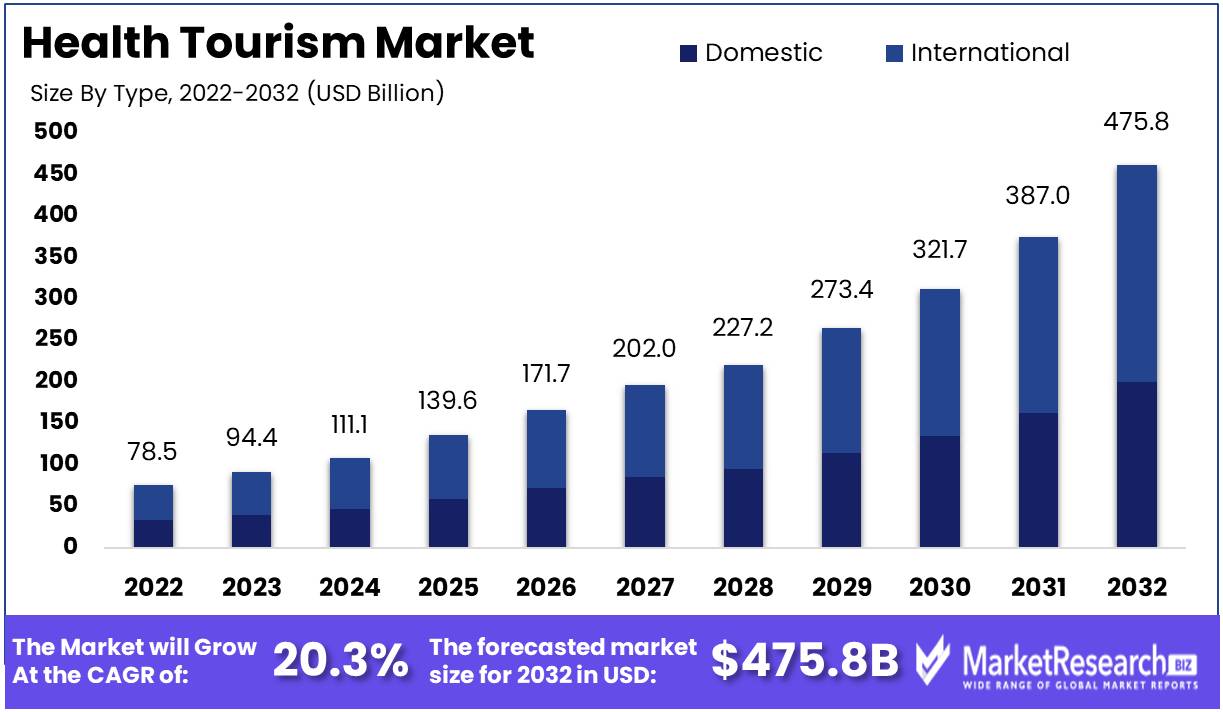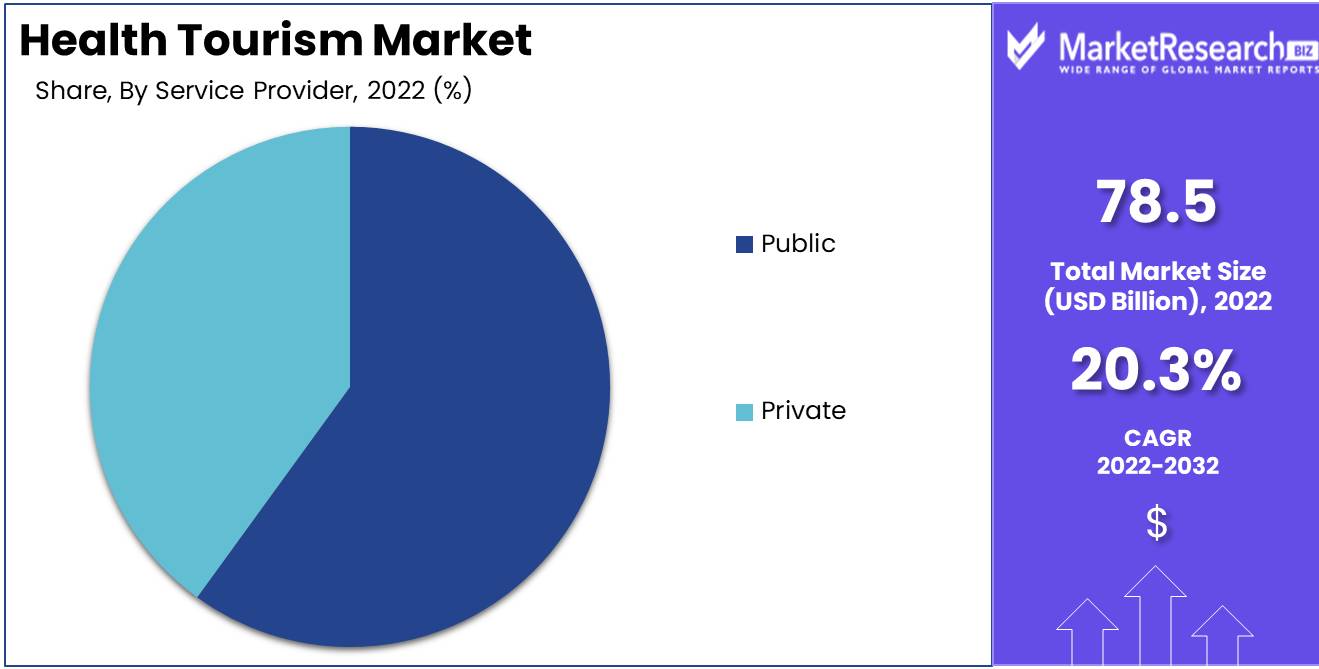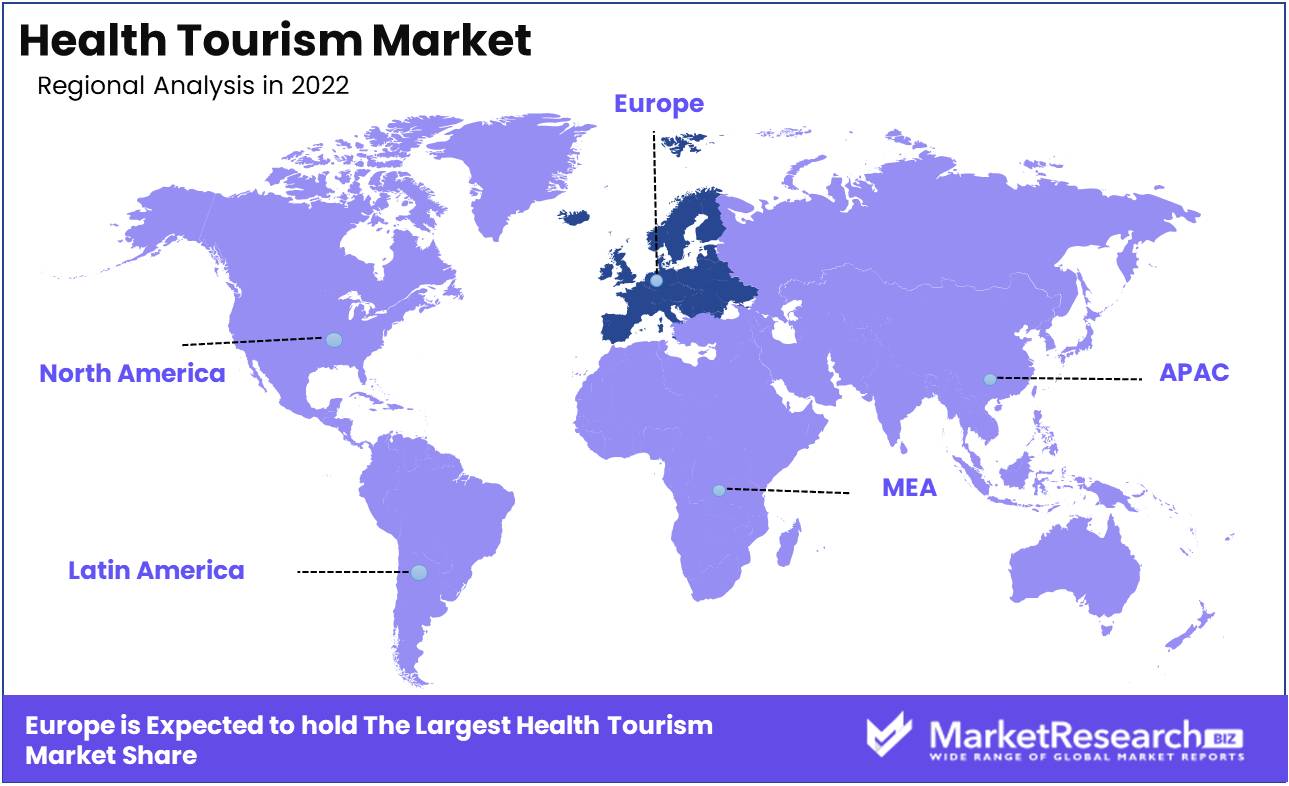
Health Tourism Market By Type (Domestic, International), By Treatment Type (Dental Treatment, Cardiovascular Treatment, Cancer Treatment, and Other Treatment Types), By Service Provider (Public, Private), By Region And Companies - Industry Segment Outlook, Market Assessment, Competition Scenario, Trends, And Forecast 2023-2032
-
39901
-
July 2023
-
189
-
-
This report was compiled by Correspondence Linkedin | Detailed Market research Methodology Our methodology involves a mix of primary research, including interviews with leading mental health experts, and secondary research from reputable medical journals and databases. View Detailed Methodology Page
-
Quick Navigation
Report Overview
Health Tourism Market size is expected to be worth around USD 475.8 Bn by 2032 from USD 78.5 Bn in 2022, growing at a CAGR of 20.3% during the forecast period from 2023 to 2032.
Health tourism, also known as medical tourism or medical travel, refers to the practice of traveling to another country or region to receive medical treatment. This concept has gained significant popularity in recent years, with more and more people exploring the option of seeking healthcare services abroad. The health tourism market aims to provide individuals with access to healthcare services that may be more affordable, accessible, or of higher quality in a different country.

This industry encompasses a broad range of medical procedures, including but not limited to cosmetic surgery, dental treatment, fertility treatments, organ transplants, and orthopedic surgeries. The motivation behind health tourism can vary from seeking specialized procedures not available in one's home country to accessing cost-effective treatments or reducing waiting times for urgent medical needs.
One of the significant advantages of health tourism is the potential for cost savings. Medical treatments in some countries can be significantly more expensive compared to others. By traveling to a destination where the treatment is more affordable, patients can save a substantial amount of money. This cost advantage is especially relevant for individuals without adequate health insurance coverage or facing high deductibles and copays.
Various industries have recognized the potential of the health tourism market and have started investing in this sector. Travel and tourism companies, airlines, hotel chains, and insurance providers have all tapped into this market to offer specialized services tailored to medical travelers. Some of these companies have even formed strategic partnerships with healthcare providers to offer comprehensive packages that include travel, accommodation, and medical treatment.
However, it is important to address the ethical concerns and responsible practices associated with health tourism. Transparency, explainability, and accountability should be central to the practices followed by healthcare providers and facilitators involved in medical tourism. Both the source and destination countries must ensure that high ethical standards are adhered to, and that patients are fully informed about the risks, benefits, and potential outcomes of the medical treatment they seek.
Driving Factors
Increasing Healthcare Costs in Developed Countries
The healthcare landscape in developed countries has been experiencing a significant rise in costs over the years. This driving factor is greatly influencing the growth of the health tourism market. As healthcare costs continue to soar, patients are seeking alternative options to receive quality medical care at a more affordable price. In developed countries, healthcare expenses can be exorbitant, making it difficult for individuals to afford necessary medical treatments and procedures. High insurance premiums, coupled with hefty out-of-pocket expenses, have led many patients to explore healthcare options abroad. Nations offering competitive prices for medical services and treatments have capitalized on this trend, catering to individuals seeking affordable yet high-quality healthcare solutions.
Rise of International Travel and Ease of Transportation
The rise of international travel and the ease of transportation have contributed significantly to the growth of the health tourism market. Advancements in aviation and the accessibility of travel options have made it easier for patients to reach their desired healthcare destinations. Gone are the days when patients had to endure long and arduous journeys to receive medical care abroad. With the convenience of modern transportation, patients can now travel to their chosen destination within a matter of hours. This ease of travel has further encouraged individuals to explore healthcare options beyond their home countries, fostering the growth of the health tourism market.
Expanding Demand for Elective and Specialized Medical Procedures
Another driving factor in the health tourism market is the expanding demand for elective and specialized medical procedures. While routine medical treatments can be easily accessed within one's home country, certain advanced procedures and specialized treatments may not be readily available or affordable. Countries that recognize this demand have experienced growth in their health tourism sectors by offering a wide range of elective and specialized medical procedures. Cosmetic surgeries, fertility treatments, orthopedic surgeries, and dental procedures are just a few examples of medical services that patients seek abroad. By providing these services, destination countries cater to the growing demand while also offering competitive pricing and quality care.
Restraining Factors
Potential Language and Cultural Barriers in the Health Tourism Market
In the rapidly growing industry of health tourism, various restraining factors emerge that can hinder its overall potential and progress. These factors include potential language and cultural barriers, potential quality and safety concerns, potential regulatory and legal complexities, potential healthcare system and infrastructure limitations, as well as potential affordability and accessibility challenges for certain patient groups. Understanding and addressing these barriers is crucial to ensure the successful development and advancement of the health tourism market.
Potential Quality and Safety Concerns in the Health Tourism Market
Another significant restraining factor in the health tourism market is the concern over quality and safety. Patients considering medical treatment abroad often worry about the standard of care provided by healthcare facilities in foreign countries. They may question the qualifications and expertise of healthcare professionals, as well as the adherence to internationally recognized standards and protocols. Additionally, there could be concerns about the quality and safety of medical equipment, medications, and facilities. These uncertainties can lead potential patients to opt for treatment within their own country, limiting the growth of health tourism.
Potential Regulatory and Legal Complexities in the Health Tourism Market
The health tourism market is also subject to potential regulatory and legal complexities. Each country has different regulations and legal frameworks governing medical tourism, making it challenging to establish consistent guidelines and standards across borders. The lack of harmonization can create confusion and uncertainty for both patients and healthcare providers. Additionally, legal issues related to liability, malpractice, and insurance coverage can arise when patients seek treatment abroad. These complexities create barriers to the development and expansion of the health tourism market.
Potential Healthcare System and Infrastructure Limitations in the Health Tourism Market
The quality and accessibility of healthcare systems and infrastructure are vital factors for patients considering medical tourism. In some regions, the healthcare infrastructure may be underdeveloped or inadequate to cater to the needs of international patients. A lack of modern facilities, advanced medical technologies, and specialized healthcare professionals can deter potential patients from seeking treatment abroad. Additionally, the availability of post-treatment care and rehabilitation services can also influence the decision-making process of patients. These limitations pose challenges to the growth and expansion of the health tourism market.
Type Analysis
The health tourism market has experienced substantial growth, and one dominant segment is the International Treatment Segment, providing medical procedures to patients who travel to other countries for healthcare services. The segment's prominence can be attributed to rising awareness and affordability of healthcare in emerging economies, enabling patients to seek advanced treatments in developed countries. Additionally, the segment's diverse range of medical services, from cosmetic surgeries to organ transplants, attracts patients globally seeking specialized healthcare not readily available in their home countries.
Furthermore, consumer trends and behavior towards the International Treatment Segment have been positive. Patients perceive international treatments as more advanced and of higher quality, making them willing to travel long distances to access these services. The convenience of combining medical treatments with leisure activities, known as medical tourism, is also a driving factor for consumer behavior towards the International Treatment Segment.
With its strong growth potential, the International Treatment Segment is expected to register the fastest growth rate in the health tourism market over the forthcoming years. This can be attributed to the continuous advancements in medical technology and procedures, as well as the increasing number of collaborations between healthcare providers across different countries. These factors are likely to attract more patients seeking international treatments and contribute to the growth of the segment.
Treatment Type Analysis
The Cancer Treatment Segment is another dominant player in the health tourism market. Cancer treatment requires specialized care and facilities, making it one of the most sought-after medical services for patients traveling abroad. Economic development in emerging economies plays a significant role in driving the adoption of the Cancer Treatment Segment. As these economies experience rapid growth, there is an increased demand for advanced medical treatments, including cancer treatment. However, limited healthcare infrastructure and expertise in these countries drive patients to seek treatment in countries with better facilities and specialized expertise.
Consumer trends and behaviors towards the Cancer Treatment Segment also contribute to its dominance. Patients are increasingly willing to travel for cancer treatment due to the perception that certain countries have a better success rate and access to advanced treatment options. Moreover, the availability of personalized treatment plans, clinical trials, and access to experimental therapies in destination countries further attract patients seeking cancer treatment.
The Cancer Treatment Segment is anticipated to register the fastest growth rate over the forthcoming years due to various factors. Firstly, the increasing prevalence of cancer globally is expected to drive the demand for cancer treatments, thus boosting the growth of this segment. Additionally, advancements in cancer research, technology, and treatment options are likely to attract more patients seeking cutting-edge treatments and better outcomes.
Service Provider Analysis
In the health tourism market, the Public Segment dominates as a service provider. Public healthcare institutions, such as government-funded hospitals and medical centers, play a significant role in providing healthcare services to patients traveling for medical treatments.
The dominance of the Public Segment can be attributed to several factors. Firstly, public healthcare institutions are often perceived as reliable and trustworthy due to their affiliation with government bodies. This factor attracts patients who prioritize safety and quality in their choice of healthcare service providers.
Moreover, public healthcare institutions are known for their affordable healthcare services compared to private clinics and hospitals. This affordability factor makes them an attractive option for patients, especially those from emerging economies, where healthcare costs can be high.
The Public Segment is anticipated to register the fastest growth rate in the health tourism market over the forthcoming years. This can be attributed to the continuous investments and development initiatives by governments in emerging economies to improve their healthcare infrastructure and services. The increasing accessibility and quality of public healthcare institutions in these economies are expected to attract more patients, further driving the growth of this segment.

Key Market Segments
By Type
- Domestic
- International
By Treatment Type
- Dental Treatment
- Cardiovascular Treatment
- Cancer Treatment
- Cosmetic Treatment
- Orthopedic Treatment
- Neurological Treatment
- Fertility Treatment
- Other Treatment Types
By Service Provider
- Public
- Private
Growth Opportunity
Diversification of Treatment Offerings
In order to cater to the diverse needs of medical tourists, healthcare providers can expand their range of treatment offerings. By embracing new medical specialties or sub-specialties, they can attract a wider spectrum of patients seeking tailored treatments. For instance, integrating cutting-edge cosmetic and aesthetic procedures, advanced fertility and reproductive treatments, or advanced orthopedic and sports medicine services can provide a competitive edge in the health tourism market.
Development of Holistic Wellness Programs
With the growing interest in wellness tourism, healthcare providers can incorporate holistic wellness programs into their offerings. By combining traditional medical treatments with alternative therapies such as yoga, meditation, and mindfulness practices, they can provide a comprehensive health and wellness experience for medical tourists. This approach not only enhances patient satisfaction but also opens new avenues for collaboration with wellness resorts and spas to offer integrated packages.
Targeting Niche Markets and Medical Specialties
In the realm of medical tourism, expanding into emerging markets is essential, but targeting niche markets and medical specialties is equally vital. Focusing on specific medical disciplines like cardiology, oncology, or advanced neurological care allows healthcare providers to establish themselves as experts in their fields. This specialization attracts patients seeking highly specialized treatments and enhances the destination's reputation in the global health tourism market.
The Power of Collaboration in Health Tourism
Collaboration plays a pivotal role in the health tourism industry, and we understand the significance of forging partnerships with travel agencies and hospitality providers. By working together, we can create seamless travel and stay experiences for our patients, ensuring they feel fully supported throughout their medical journey. This collaborative approach enhances the overall patient experience and contributes to the success of health tourism destinations.
Latest Trends
Growth of Cosmetic and Aesthetic Procedures in Health Tourism
Cosmetic and aesthetic procedures have become increasingly popular among individuals seeking to enhance their appearance and boost their self-confidence. With the advancement of medical technology, these procedures have become more accessible and affordable, driving the growth of health tourism. People are now traveling to different countries to avail themselves of such treatments, lured by the combination of cost-effectiveness, expertise, and state-of-the-art facilities offered by foreign healthcare providers.
Demand for Dental and Fertility Treatments
The demand for dental and fertility treatments has witnessed a remarkable surge in the health tourism industry. Dental tourism has gained traction due to the significant cost savings associated with dental procedures in certain countries. Patients are willing to travel across borders to receive high-quality dental care at a fraction of the cost in their home countries. Similarly, fertility treatments, including in-vitro fertilization (IVF) and surrogacy, are becoming increasingly sought after. As treatment success rates improve and affordable options arise, individuals are exploring medical travel as a viable solution to their fertility challenges.
Rise of Destination Marketing and Medical Tourism Packages
The health tourism market has witnessed a significant boost through destination marketing and the introduction of medical tourism packages. Countries with well-established healthcare systems are actively promoting their medical facilities to attract international patients. By investing in comprehensive marketing campaigns and strategic collaborations with travel agencies, these destinations successfully position themselves as premier healthcare destinations. The advent of medical tourism packages that offer inclusive solutions, including travel, accommodation, and treatment, has further facilitated the growth and appeal of health tourism.
Adoption of Telemedicine and Teleconsultation Services
The advent and widespread adoption of telemedicine and teleconsultation services have revolutionized the health tourism industry. With technological advancements, individuals can now remotely consult healthcare professionals, receive medical advice, and even undergo certain diagnostic procedures without physically traveling to another country. Telemedicine has not only expanded access to quality healthcare but has also bridged the gap between patients and healthcare providers, irrespective of geographical boundaries.
Regional Analysis
Europe Region Dominates the Health Tourism Market, It has emerged as the frontrunner in the global health tourism industry, solidifying its position as the dominant player in this burgeoning market. With a rich diversity of healthcare services, cutting-edge medical facilities, highly skilled professionals, and attractive destinations, Europe has become the go-to region for individuals seeking top-quality medical treatments combined with a memorable travel experience.
One of the reasons behind Europe's dominance in health tourism is its ability to strike the perfect balance between medical excellence and the lure of exploration. Patients can not only recover in comfortable, luxurious settings but also explore the rich history, vibrant culture, and breathtaking landscapes Europe has to offer. From the historic landmarks of Rome to the picturesque landscapes of Switzerland, patients can indulge in a truly memorable experience while undergoing their medical treatments.
Another factor contributing to Europe's dominance is its vast network of highly skilled and experienced healthcare professionals. Renowned for their expertise and commitment to patient care, European doctors and medical staff are applauded globally for their professionalism and mastery of their respective fields. Patients have the confidence that their healthcare needs will be met with the highest standards of quality and safety.
The European Union has been instrumental in driving health tourism growth by fostering cooperation among member states, facilitating patient mobility, and setting common quality standards. This collaboration has positioned Europe as a leading provider of accessible and high-quality medical care worldwide. Additionally, Europe's commitment to continuous innovation through substantial investments in research and development ensures that it remains a sought-after destination for advanced medical treatments and procedures.

Key Regions and Countries
North America
- US
- Canada
- Mexico
Western Europe
- Germany
- France
- The UK
- Spain
- Italy
- Portugal
- Ireland
- Austria
- Switzerland
- Benelux
- Nordic
- Rest of Western Europe
Eastern Europe
- Russia
- Poland
- The Czech Republic
- Greece
- Rest of Eastern Europe
APAC
- China
- Japan
- South Korea
- India
- Australia & New Zealand
- Indonesia
- Malaysia
- Philippines
- Singapore
- Thailand
- Vietnam
- Rest of APAC
Latin America
- Brazil
- Colombia
- Chile
- Argentina
- Costa Rica
- Rest of Latin America
Middle East & Africa
- Algeria
- Egypt
- Israel
- Kuwait
- Nigeria
- Saudi Arabia
- South Africa
- Turkey
- United Arab Emirates
- Rest of MEA
Key Players Analysis
The health tourism sector is currently witnessing substantial growth, characterized by the presence of dominant players within the market. Apollo Hospitals Enterprise Ltd., Fortis Healthcare, KPJ HEALTHCARE BERHAD, Nippon Telegraph and Telephone East Corporation, ADITYA BIRLA HEALTH SERVICES LTD., and Samitivej PCL are notable contenders in the healthcare industry, distinguished by their distinct healthcare solutions and services. These companies have effectively drawn medical tourists in search of high-quality healthcare services by offering top-notch infrastructure, cutting-edge medical technology, and highly skilled professionals.
Apollo Hospitals Enterprise Ltd. is widely recognized as a prominent entity within the healthcare sector, both domestically in India and on an international scale. Apollo Hospitals has established itself as a prominent player in the health tourism industry, owing to its exceptional infrastructure, advanced technology, and proficient team of medical experts. The medical facility provides an extensive array of medical interventions and healthcare provisions, encompassing specialized surgical procedures, organ transplantation, cancer therapy, and cardiac healthcare. The hospital's dedication to providing high-quality healthcare and adopting a patient-centric approach has resulted in the establishment of a robust reputation among individuals who travel for medical purposes.
Fortis Healthcare, an India-based company, is a significant participant in the health tourism industry. Fortis Healthcare, boasting an extensive network of hospitals spanning the nation, offers a wide array of medical services encompassing diagnostics, preventive health check-ups, and critical care. The hospital group is renowned for its cutting-edge facilities, highly skilled medical practitioners, and exceptional standards of patient care. The dedication of Fortis Healthcare to upholding ethical standards, promoting transparency, and ensuring affordability has positioned it as a favored option among individuals seeking medical treatment abroad.
Aditya Birla Health Services Ltd., a subsidiary of the esteemed Aditya Birla Group, holds a prominent position within the healthcare sector in India. The organization operates a network of multispecialty hospitals and medical centers, offering a wide range of comprehensive healthcare services. ADITYA BIRLA HEALTH SERVICES LTD. has emerged as a prominent player in the health tourism sector, owing to its emphasis on patient-centric care, utilization of advanced medical technology, and a team comprising proficient medical practitioners. The company's focus on innovation, research, and collaboration serves to enhance its standing within the industry.
Top Key Players in Health Tourism Market
- Apollo Hospitals Enterprise Ltd. (India)
- Fortis Healthcare (India)
- KPJ HEALTHCARE BERHAD (Malaysia)
- Nippon Telegraph and Telephone East Corporation (Japan)
- ADITYA BIRLA HEALTH SERVICES LTD. (India)
- Samitivej PCL (Thailand)
- BB Healthcare Solutions (U.K.)
- UZ LEUVEN (Belgium)
- Berkalp Co-Limited (Ireland)
- MEDIC ABROAD (U.S.)
- AMERICAN MEDICAL CARE (U.S.)
- MEDICINE PARK UNITED KINGDOM (U.K.)
- Hospital Galenia
- Centro Médico ABC (Mexico)
Recent Development
- In 2022, Not to be outdone, Malaysia followed suit by launching an ambitious health tourism promotion campaign. With its tropical landscapes and world-class medical facilities, Malaysia seeks to position itself as a top choice for medical tourists. The campaign aims to highlight the country's diverse healthcare options, from wellness retreats to specialized medical treatments, and it complements Malaysia's thriving medical tourism industry. By emphasizing the unique blend of modern medicine and traditional healing practices, Malaysia aims to attract a growing number of health-conscious travelers seeking holistic healthcare experiences.
- In 2021, Building on this momentum, India's announcement about the inauguration of a new health tourism center in New Delhi further signifies the country's commitment to becoming a premier healthcare destination. Equipped with state-of-the-art facilities and employing highly skilled medical professionals, this center aims to attract patients from around the globe seeking advanced medical treatments. India's rich cultural heritage and affordable healthcare offerings make it an enticing choice for medical tourists seeking high-quality care with a touch of cultural immersion.
- In 2020, Singapore made headlines when it declared a collaboration with tech giant Google to establish a pioneering health tourism platform. This digital initiative seeks to streamline the medical tourism experience, providing seamless access to a wide range of healthcare providers, comprehensive medical information, and personalized travel arrangements. By leveraging Google's expertise and Singapore's world-class healthcare system, both convenience and quality are set to be prioritized for international patients.
Report Scope
Report Features Description Market Value (2022) USD 78.5 Bn Forecast Revenue (2032) USD 475.8 Bn CAGR (2023-2032) 20.3% Base Year for Estimation 2022 Historic Period 2016-2022 Forecast Period 2023-2032 Report Coverage Revenue Forecast, Market Dynamics, COVID-19 Impact, Competitive Landscape, Recent Developments Segments Covered By Type (Domestic, International)
By Treatment Type (Dental Treatment, Cardiovascular Treatment, Cancer Treatment, Cosmetic Treatment, Orthopedic Treatment, Neurological Treatment, Fertility Treatment, Other Treatment Types)
By Service Provider (Public, Private)Regional Analysis North America – The US, Canada, & Mexico; Western Europe – Germany, France, The UK, Spain, Italy, Portugal, Ireland, Austria, Switzerland, Benelux, Nordic, & Rest of Western Europe; Eastern Europe – Russia, Poland, The Czech Republic, Greece, & Rest of Eastern Europe; APAC – China, Japan, South Korea, India, Australia & New Zealand, Indonesia, Malaysia, Philippines, Singapore, Thailand, Vietnam, & Rest of APAC; Latin America – Brazil, Colombia, Chile, Argentina, Costa Rica, & Rest of Latin America; Middle East & Africa – Algeria, Egypt, Israel, Kuwait, Nigeria, Saudi Arabia, South Africa, Turkey, United Arab Emirates, & Rest of MEA Competitive Landscape Apollo Hospitals Enterprise Ltd. (India), Fortis Healthcare (India), KPJ HEALTHCARE BERHAD (Malaysia), Nippon Telegraph and Telephone East Corporation (Japan), ADITYA BIRLA HEALTH SERVICES LTD. (India), Samitivej PCL (Thailand), BB Healthcare Solutions (U.K.), UZ LEUVEN (Belgium), Berkalp Co-Limited (Ireland), MEDIC ABROAD (U.S.), AMERICAN MEDICAL CARE (U.S.), MEDICINE PARK UNITED KINGDOM (U.K.), Hospital Galenia, Centro Médico ABC (Mexico) Customization Scope Customization for segments, region/country-level will be provided. Moreover, additional customization can be done based on the requirements. Purchase Options We have three licenses to opt for: Single User License, Multi-User License (Up to 5 Users), Corporate Use License (Unlimited User and Printable PDF) -
-
- Apollo Hospitals Enterprise Ltd. (India)
- Fortis Healthcare (India)
- KPJ HEALTHCARE BERHAD (Malaysia)
- Nippon Telegraph and Telephone East Corporation (Japan)
- ADITYA BIRLA HEALTH SERVICES LTD. (India)
- Samitivej PCL (Thailand)
- BB Healthcare Solutions (U.K.)
- UZ LEUVEN (Belgium)
- Berkalp Co-Limited (Ireland)
- MEDIC ABROAD (U.S.)
- AMERICAN MEDICAL CARE (U.S.)
- MEDICINE PARK UNITED KINGDOM (U.K.)
- Hospital Galenia
- Centro Médico ABC (Mexico)




